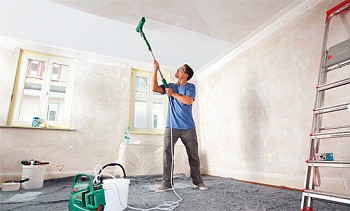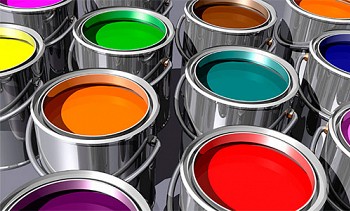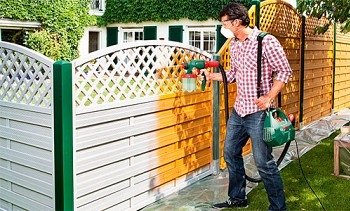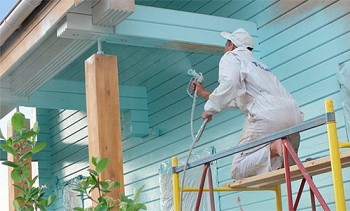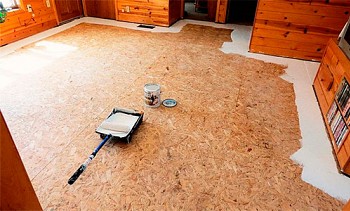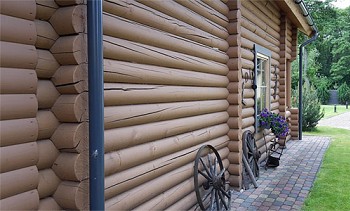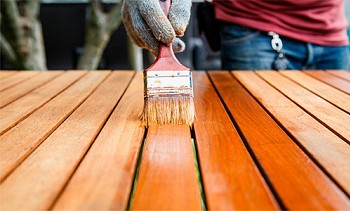Enamel PF 115, the technical characteristics of which are not inferior to branded paints from the best manufacturers in the world, has excellent adhesion to almost all building and construction materials, is very easy to use, safe in an environmental sense and has good decorative properties. In addition, it is waterproof, not afraid of ultraviolet radiation, quite elastic. We will talk about these and other properties of the popular paint in more detail.
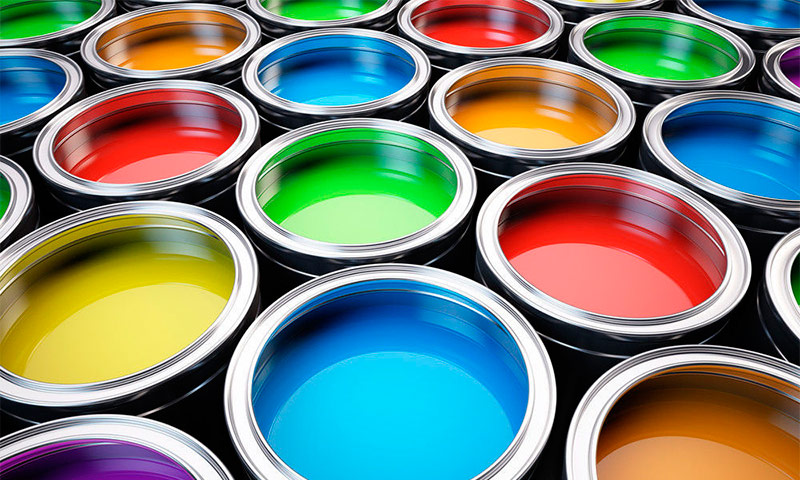
Content:
What does marking PF-115 mean?
Enamel PF-115, well known to professional builders and owners of private houses, appeared on the market in the distant 60s of the last century. Until now, it remains one of the most practical paints for various kinds of repair and construction works. Such durability is due not only to the low price, but also to a number of unique consumer qualities.
Paint is produced almost unchanged from the day it first entered the market. Regulates its composition GOST 6465-76. If you want to use the classic PF 115, then buy paint made in accordance with GOST. Many manufacturers make changes in the chemical composition and produce paint according to technical specifications. It is very difficult to guess whether its properties are improved or worsened; it can only be verified experimentally. But there is not always time to do this, and not everyone can afford to buy paint, albeit inexpensive, for experiments.

In the name of PF 115, the chemical composition and main areas of application are encrypted. The index is understandable to the specialist, but does not mean anything to the average buyer. However, the information is very important.
PF letter symbol indicates that the binder of the paint is pentaphthalic varnish (a type of alkyd resin). The scope of pentaphthalic paints is external and internal work on a wide range of materials.
The numbers 115 indicate the scope of application:
- 1 - for outdoor work in various climatic conditions;
- 15 - chemical composition number, determined by GOST and decrypted by the manufacturer.
In its physical state, PF-115 paint is a suspension, a suspension of various types of solid and liquid particles in a liquid medium. Particles are represented by solvents, dyes, pigments, desiccants, titanium dioxide and other fillers. The base is a fairly viscous pentaphthalic varnish that dissolves with white spirit or other organic liquids.
The chemical composition of the paint PF-115
In the classic form, the composition of the PF 115 paint includes different components, depending on the color. Different types of enamel differ, both in the number of components and in their percentage ratio. But the peculiarity of this paint is that, regardless of the composition, the main operational properties remain unchanged.
Paint is made in ready-made colors, you can change the shade only by mixing different modifications of PF 115 in a certain proportion. Moreover, by mixing a precisely metered test quantity of different paints and obtaining the desired color, you can proportionally increase the volume of components and prepare the required supply of paint of the desired selected shade.
As an example, we consider the composition of the most common types of PF 115 paint, the technical characteristics of which largely coincide.
White:
1. pentaphthalic varnish - 28%;
2. titanium dioxide - 62%;
3. white spirit - 10%.
Blue:
1. varnish - 26%;
2. TiO2 - 60%;
3. zinc white - 6%;
4. light blue - 4%;
5. solvent - 4%.
Gray:
1. Varnish - 20%;
2. TiO2 - 75%;
3. carbon black - 0.5%;
4. solvent - 4.5%.
The paint produced according to GOST exactly corresponds to this chemical composition and the coating will have the qualities indicated in the paint certificate.

Technical characteristics of PF-115 paint
As already mentioned, the paint has a number of properties that are quite unique in this combination, which allowed the composition to withstand fierce competition and survive on the market for more than half a century. At the same time, enamel is one of the most popular, which in itself is a unique phenomenon.
We will show the main characteristics of the PF-115 paint in the form of a table:
| Mass fraction of non-volatiles,% | 49-70 |
| Surface gloss,% | ≥ 50 |
| Conditional viscosity at T = 20 0FROM | 60 -120 |
| Drying time at 20 0S | ≤ 24 |
| Bending elasticity | ≤ 1 |
| Hardness units | 0,15-0,25 |
| Impact strength | ≥ 40 |
| Film adhesion level, points | 1 |
| Spreading rate g / m2 | 60 – 100 |
| Water resistance | ≥ 2 |
| Oil resistance, h | ≥ 24 |
| Resistance to detergents, h | ≥ 15 |
| Consumption, kg / m2 | 0,1 – 0,18 |
| Combustibility group | flammable |
| Smell | pronounced |
| Toxicity | moderate |
According to its properties, PF-115 enamel requires careful handling, especially when used indoors. Before work, it is necessary to check the operability of ventilation and the absence of sources of open flame. It is also not recommended to use heat guns, both on liquid fuel, and with electric heating.
Appointment and scope
Due to its high viscosity and excellent adhesion, the use of PF 115 paint is very wide.
The composition can be painted:
- wood;
- concrete;
- plaster;
- putty;
- brick;
- metal.
Unless it is suitable only for roofing works - with strong heating of slate or tin sheets, cracks can appear and the color changes greatly.
Enamel is used mainly for external work for structures located in the open air. It is used both in the form of a monolayer coating and as a part of multilayer coatings, in combination with soils, anticorrosive and antiseptic impregnations, insulating layers. Enamel does not have its own antiseptic and bactericidal properties, therefore, when treating wood and brick or concrete walls in wet conditions, such additives are necessary.
It has PF-115 enamel and very high decorative properties - according to GOST 6465-76, it is produced in 22 colors and shades. In recent decades, manufacturers have offered modernized paint, which is available in almost all colors of the RAL scale. In this case, the color number from the catalog is indicated on banks or barrels of paint. This is one of the few cases when it is preferable to buy paint made not according to GOST than standard. But it must be noted that this type of enamel costs more than usual due to the use of expensive dyes.





The high elasticity of the film, which can be obtained by painting surfaces in two or more layers (a single-layer coating is used only when updating a previously finished finish with the same paint, provided that it does not have cracks and swellings) allows PF 115 to be used in completely different climatic conditions. The temperature range at which the finished coating retains its properties is incredible - 50 ... + 60 0C. But the paint is fully consistent with the declared characteristics only subject to all technological rules for applying the coating layer. How to use enamel we will tell further.
Application and recommended paint schemes
Waterproof alkyd enamel PF 115 can be applied with any type of paint tool - brush, roller, spray. When calculating the amount of paint needed, it is imperative to take into account the feature of the surface to be painted and the color of the paint.
Concrete, brick, unpolished wood absorb paint quite intensively and its consumption will be greater than when coating planed wood, metal or previously painted surfaces.
Selection of the amount of paint by color
Depending on the color, the consumption of standard paint is in a fairly large range. At room temperature for painting 1 m2 the same non-primed surface will need:

0.1-0.14 kg -
white paints

0.05 - 0.06 kg -
black paints

0.07 - 0.1 kg -
blue paints

0.07 - 0.08 kg -
brown paints

0.1 - 0.2 kg -
red paint
The calculation is given for single-layer painting. When determining the real one, the number of layers is multiplied by the figures given and again multiplied by a coefficient of 0.9 - less paint is used for each subsequent layer than for the first. The second coat can be applied no earlier than 24 hours after the completion of the previous coating.
The surfaces are painted only perfectly dry, warmed to a temperature of at least +5 0C. It is optimal to carry out paint work using PF 115 in dry, calm weather at an ambient temperature in the range +15 ... + 22 0C. In this case, the paint will retain optimal viscosity, the solvent will not evaporate too quickly from the surface, and the risk of sagging will be minimized.
The method of application also affects the paint consumption. When using a roller, it will be larger than a brush, and a spray can lead to some overspending. Also, the average consumption directly depends on the quality of surface preparation for painting and compliance with standard paint application patterns.
Coloring schemes enamel PF-115
1. Coloring metal.
Metals of all types are painted with enamel only after priming with the compositions GF 0119, VL 05, GF 021 or their analogues, compatible with pentaphthalic paints. The number 0 must always be the first in the index of primers. If there are no primers, and the surfaces are not very responsible, then PF 115 enamel diluted with white spirit to 50% of the initial density can be used for the primer.
Surfaces bearing traces of corrosion are treated with rust inhibitors (converters) of the Unicor type before the primer. These compounds are applied after mechanical cleaning of the metal from rust and grease. They turn corrosion products into durable and dense joints that do not differ in hardness from solid metal. Metals are painted with PF 115 enamel in two layers.

2. Coloring a tree.
Enamel is applied on wood without primer in 2 - 3 layers. If necessary (recommended), treat the wood surface with flame retardants, antiseptics and fungicides compatible with pentaphthalic paints. Manufacturers of paint and varnish coatings offer a wide selection of such compositions, but when using them, it is necessary to carefully study the instructions - some of them are designed for acrylic paints, some act as an independent coating.

3. Stucco, concrete, brick.
These materials are painted with enamel in 2 to 3 layers without a primer. But it is advisable to use anti-mold preparations - enamel forms a dense surface with low vapor permeability and residual moisture can cause favorable conditions for the development of mold and fungus in the massif of material if there are spore pests.

When painting any of the materials, the surface must be thoroughly cleaned of dust and dried. Residual humidity should not exceed 10 - 15%. Fresh concrete walls and foundations, as well as brick structures, can be painted no earlier than six months after the end of installation. The interval between applying the next coat of paint is at least a day.
In most cases, in factory containers, the paint is sold completely ready for use. But after opening the can, the solvent begins to evaporate intensively and the enamel density increases. To bring the paint to a working consistency, white spirit or solvent is used, as well as mixtures thereof. Gasoline and kerosene are not recommended - although they dissolve the enamel, they significantly change its shade and luster.
When preparing the paint for work, it must be thoroughly mixed, adding the solvent in small portions. In the process, the paint also needs to be mixed periodically.

